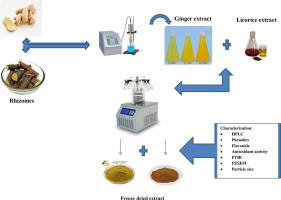Ultrasonics Sonochemistry ( IF 8.4 ) Pub Date : 2022-05-26 , DOI: 10.1016/j.ultsonch.2022.106048 Romee Jan 1 , Adil Gani 2 , Mohd Masarat Dar 1 , Naseer Ahmad Bhat 1

|
Ginger (Zingiber officinale) and Licorice (Glycyrrhiza glabra L.) are one of the most popular spices having a wide range of bioactive compounds that have varied biological and pharmacological properties. The study was aimed to extract polyphenols from Himalayan medicinal herbs ginger and licorice in different solvents using ultra-sonication technique. The extraction efficiency (EE) was determined, and the extracts were characterized for physical properties (particle size, colour values), total phenolics, flavonoids, antioxidant properties, and structural and morphological features. Ultra-sonicated ginger in aqueous phase had the highest EE of polyphenols (15.27%) as compared to other solvents. Similar trend was observed in licorice with EE of 30.52 % in aqueous phase followed by ethanol: water (50: 50), and methanol: water (50:50) with 28.52% and 26.39%, respectively. The preliminary screening showed the presence of tannins, phenolics, flavonoids, saponins and carbohydrates, steroids and alkaloids in all the extracts. The phenolic and flavonoid content of dried ginger was found higher in ethanolic extracts compared to fresh ones as revealed by HPLC. Similarly, for licorice, the ethanolic fractions had the highest polyphenolic content. The representative samples of ginger (ethanol: water 75:25 and ethylacetate: water 75:25) and licorice (ethanol: water 70:30 and methanol: water 50:50) were studied for FESEM and particle size. The results showed the agglomerated extract micro-particles with a diameter of 0.5–10 µm and increased particle size (ginger: 547 and 766 nm), and (licorice: 450 and 566 nm). The findings could be beneficial for the advancement of ginger and licorice processing, for the comprehension of these herbs as a source of natural antioxidants in different food formulations.
中文翻译:

超声波处理的生姜(Zingiber officinale)和甘草(Glycyrrhiza Glabra)冻干提取物的生物活性表征
姜 ( Zingiber officinale ) 和甘草 ( Glycyrrhiza glabra L ).) 是最受欢迎的香料之一,具有多种生物活性化合物,具有不同的生物学和药理学特性。本研究旨在利用超声技术在不同溶剂中从喜马拉雅药材生姜和甘草中提取多酚。测定了提取效率 (EE),并对提取物的物理特性(粒度、色值)、总酚类物质、类黄酮、抗氧化特性以及结构和形态特征进行了表征。与其他溶剂相比,水相中超声处理的姜的多酚 EE 最高(15.27%)。在甘草中观察到类似的趋势,水相中的 EE 为 30.52%,其次是乙醇:水 (50:50) 和甲醇:水 (50:50),分别为 28.52% 和 26.39%。初步筛选表明,所有提取物中都存在单宁、酚类、黄酮类、皂苷和碳水化合物、类固醇和生物碱。HPLC 显示,与新鲜姜相比,乙醇提取物中干姜的酚类和黄酮类化合物含量更高。同样,对于甘草,乙醇部分的多酚含量最高。研究了姜(乙醇:水 75:25 和乙酸乙酯:水 75:25)和甘草(乙醇:水 70:30 和甲醇:水 50:50)的代表性样品的 FESEM 和粒度。结果表明,聚集的提取物微粒直径为 0.5–10 µm,粒径增加(生姜:547 和 766 nm)和(甘草:450 和 566 nm)。这些发现可能有利于生姜和甘草加工的进步,



























 京公网安备 11010802027423号
京公网安备 11010802027423号